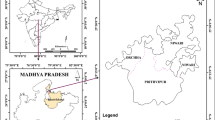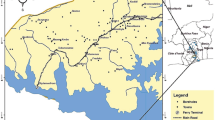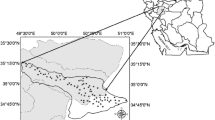Abstract
The study area is a part of central Ganga Plain which lies within the interfluve of Hindon and Yamuna rivers and covers an area of approximately 1,345 km2. Hydrogeologically, Quaternary alluvium hosts the major aquifers. A fence diagram reveals the occurrence of a single aquifer to a depth of 126 m below ground level which is intercalated by sub-regional clay beds. The depth to water level ranges from 9.55 to 28.96 m below ground level. The general groundwater flow direction is northwest to southeast. Groundwater is the major source of water supply for agricultural, domestic, and industrial uses. The overuse of groundwater has resulted in the depletion of water and also quality deterioration in certain parts of the area. This has become the basis for the preparation of a groundwater vulnerability map in relation to contamination. The vulnerability of groundwater to contamination was assessed using the modified DRASTIC-LU model. The parameters like depth to water, net recharge, aquifer media, soil media, topography, impact of vadose zone, hydraulic conductivity of the aquifer, and land use pattern were considered for the preparation of a groundwater vulnerability map. The DRASTIC-LU index is computed as the sum of the products of weights and rating assigned to each of the inputs considered. The DRASTIC-LU index ranges from 158 to 190, and is classified into four categories, i.e., <160, 160–170, 170–180, and >180, corresponding to low, medium, high, and very high vulnerability zones, respectively. Using this classification, a groundwater vulnerability potential map was generated which shows that 2 % of the area falls in the low vulnerable zone, 38 % falls in the medium vulnerable zone, and 49 % of the area falls in the high vulnerable zone. About 11 % of the study area falls in the very high vulnerability zone. The groundwater vulnerability map can be used as an effective preliminary tool for the planning, policy, and operational levels of the decision-making process concerning groundwater management and protection.







Similar content being viewed by others
References
Alam F (2010) Aquifer system and groundwater resource evaluation in parts of Hindon–Yamuna watershed in parts of western Uttar Pradesh. Unpublished Ph.D Thesis, Aligarh Muslim University, Aligarh. 227p
Aller L, Bennett T, Lehr JH, Petty RJ (1987) DRASTIC: a standardized system for evaluating groundwater pollution potential using hydrogeologic settings. US EPA/600/2-85/018
Bhatnagar NC, Agashe RM, Mishra AK (1982) “Subsurface mapping of aquifer system” water balance study of Upper Yamuna Basin. Section Hydrogeology, Technical report No.2, Upper Yamuna Project, CGWB, NW region, Chandigarh
Fritch TG, McKnight C, Yelderman JC, Arnold JG (2000) An aquifer vulnerability assessment of the Paluxy aquifer, Central Texas, USA, using GIS and a modified DRASTIC approach. J Environ Manag 25:337–345
Gogu RC, Dassargues A (2000) Current trends and future challenges in groundwater vulnerability assessment using Overlay and Index methods. Environ Geol 39(6):549–559
Herlinger R Jr, Antonio PV (2007) Groundwater vulnerability assessment in coastal plain of Rio Grande do Sul State, Brazil, using drastic and adsorption capacity of soils. Environ Geol 52:819–829
Hussain MH, Singhal DC, Joshi H, Kumar S (2006) Assessment of groundwater vulnerability in tropical alluvial interfluves, India. Bhu-Jal News No.1–4: pp 31–43
Khan AM (2004) Hydrogeology and groundwater potential of Baghpat district, U.P. Central Ground Water Board, Northern Region, India 116p
Khan MMA, Umar R, Lateh H (2010) Assessment of aquifer vulnerability in parts of Indo Gangetic plain, India. Int J Phys Sci 5(1):1711–1720
Kumar G (2005) Geology of Uttar Pradesh and Uttranchal. Geol Soc India, Bangalore, pp 267–291
Lynch SD, Reynders AG, Schulze RE (1994) Preparing input data for a national-scale groundwater vulnerability map of southern Africa. Document ESRI 94
Mendoza JA, Barmen G (2006) Assessment of groundwater vulnerability in the Rio Artiguas basin, Nicaragua. Environ Geol 50:569–580
Ministry of Water Resources (1997) Report of the groundwater resource estimation committee—groundwater resource estimation methodology. Government of India, New Delhi
Qinghai G, Yanxin W, Xubo G, Teng M (2007) A new model (DRARCH) for assessing groundwater vulnerability to arsenic contamination at basin scale: a case study in Taiyuan basin, northern China. Environ Geol 52:923–932
Rehman A (2008) A GIS based DRASTIC model for assessing groundwater vulnerability in shallow aquifers in Aligarh, India. J Appl Geogr 28(1):32–53
Umar R, Alam F (2012) Assessment of hydrogeochemical characteristics of groundwater in parts of Hindon–Yamuna interfluve region, Baghpat District, western Uttar Pradesh. J Environ Monit Assess 184:2321–2336. doi:10.1007/s10661-011-2120-9
Umar R, Ahmed I, Alam F (2009) Mapping groundwater vulnerable zones using modified DRASTIC approach of an alluvial aquifer in parts of Central Ganga Plain, Western Uttar Pradesh. J Geol Soc India 73:193–201
Vias JM, Andreo B, Perles MJ, Carrasco F (2005) A comparative study of four schemes for groundwater vulnerability mapping in a diffuse flow carbonate aquifer under Mediterranean climatic conditions. Environ Geol 47:586–595
Vrba J, Zaporozec A (1994) Guidebook on mapping groundwater vulnerability. Int Contrib Hydrogeol 16:129
Acknowledgments
The financial assistance received by the first author in the form of Senior Research Fellow from the Council of Scientific and Industrial Research (CSIR), New Delhi, is acknowledged. The authors are also thankful to the Director, National Geophysical Research Institute (CSIR), Hyderabad, India, for granting permission to publish this paper.
Author information
Authors and Affiliations
Corresponding author
Rights and permissions
About this article
Cite this article
Alam, F., Umar, R., Ahmed, S. et al. A new model (DRASTIC-LU) for evaluating groundwater vulnerability in parts of central Ganga Plain, India. Arab J Geosci 7, 927–937 (2014). https://doi.org/10.1007/s12517-012-0796-y
Received:
Accepted:
Published:
Issue Date:
DOI: https://doi.org/10.1007/s12517-012-0796-y




